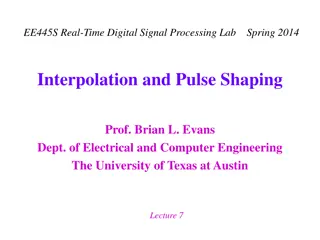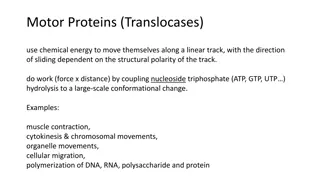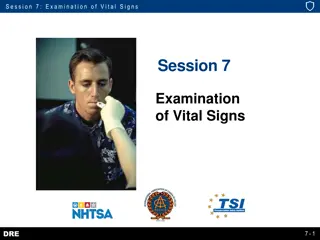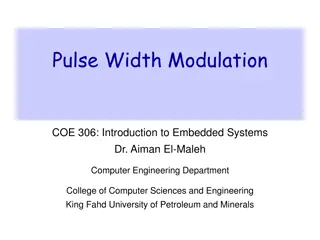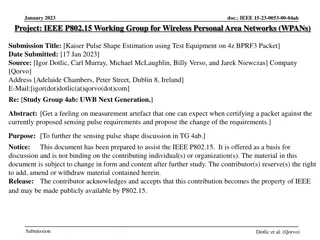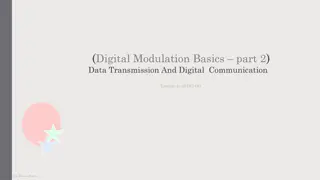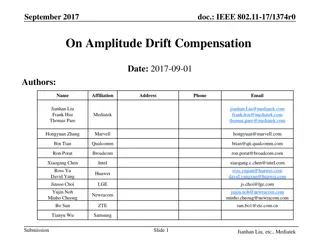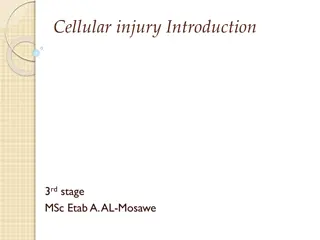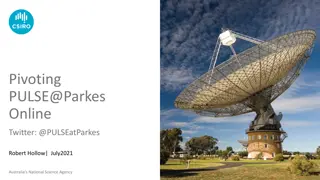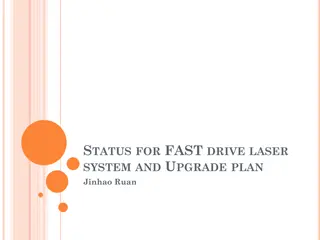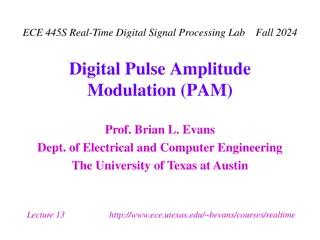Comparative Analysis of Pulse and Amplitude Modulations in Cellular Applications
Explore the comparison between various pulse modulations like PM1 and PM3, alongside amplitude modulation (AM) in the context of cellular technologies such as 2G, 4G(LTE), and advances in 5G NR. The discussion includes considerations of modulation frequency, duty cycles, and spectrum analysis to understand their implications on signal integrity and interference mitigation in modern communication systems.
Download Presentation

Please find below an Image/Link to download the presentation.
The content on the website is provided AS IS for your information and personal use only. It may not be sold, licensed, or shared on other websites without obtaining consent from the author. Download presentation by click this link. If you encounter any issues during the download, it is possible that the publisher has removed the file from their server.
E N D
Presentation Transcript
OICA and CLEPA joint contribution to GRE-90-23 and GRE-90-35
Rationale for introducing a new pulse modulations 2G (GSM) Frame Structure 4G (LTE) Frame Structure Type 2 (TDD) Frame length: 10ms (consisting of 10 sub-frames) Sub-frame length: 1ms This corresponds to PM (1000 Hz, 10% duty cycle)! Frame length: 4.16ms = 217Hz Slot length: 577 s Conclusion: An eligible modulation to emulate LTE is PM3 (1000Hz, 10% duty cycle). In order to consider multiple LTE transceivers transmitting simultaneously, the duty cycle was updated to 50%. The PM with 1000Hz and 50% modulation is also required in MIL-STD-461G. This corresponds to PM (217Hz, 577 s)! Conclusion: PM1 (217Hz, 577 s) is suitable to emulate 2G.
Envelope Spectrum of PM1 and PM3 in comparison Signal generator connected to spectrum analyzer, Carrier Frequency: 450 MHz, Level: 50 dB V; RBW: 1 Hz PM1: 217 Hz, 12,5 % duty cycle PM3: 1 kHz, 50% duty cycle PM3 covers PM1: higher modulation frequency (pulse rate) and higher duty cycle is considered to be more harmful.
Frequency ranges for state-of-the art cellular applications Excerpt of 5G NR FR1 Excerpt of 4G (LTE) frequency bands frequency bands Source: Specification # 38.101-1 (3gpp.org) Source: Specification # 36.101 (3gpp.org)
AM Modulation: Upward vs. downward modulation PM3 per ISO 11451-1 DIS (N3346) and 11452-1 DIS (N3342) AM downward modulation per ISO 11451-1:2015 & ISO 11452-1:2015 AM upward modulation per IEC 61000-4-3:2020 Peak conservation in ISO 11451-1 and 11452-1 ensures that the maximum amplitude level of AM does not exceed the maximum CW level while PM corresponds to a pulsed (i.e. on-off) CW signal. In contrast to AM, PM additionally emulates switching characteristics of a digital modulated signal.
Spectrum of AM and PM3 in comparison Signal generator connected to spectrum analyzer, Carrier Frequency: 400 MHz, Level: -10 dBm; RBW: 1 Hz AM: 1 kHz, 80% depth PM3: 1 kHz, 50% duty cycle Equal modulation frequency for AM and PM3: distance between two spectral lines is 1 kHz for both modulations.
Summary of AM use Communication applications: PM3 was introduced at 380 MHz to cover TETRA, 4G, 5G, WIFI Maritime1) applications: 1,6 27,5 MHz (J3E: single sideband without carrier) Railway2) applications: Old train station control systems might still use AM Train radio: FM or TETRA Aviation3) applications: Frequency range for civil applications: 108 - 137 MHz (Aircraft communications radio) Frequency range for military applications: 225 - 400 MHz (Aircraft communications radio) Amateur Radio4) : Focus on frequency bands with PRIMARY status: 1,8 450 MHz (and 24 250 GHz) No practical use reported in the 70 cm (420 450 MHz) band: highest frequency << 450 MHz Infotainment applications5): Radio broadcasting: LF: 0,1485 0,2835 MHz / MF: 0,5265 1,607 MHz / HF: 3,9 26,1 MHz Analog television: 47 838 MHz; Reference document does not provide detailed information on modulation; Analog television outdated digital television services apply other modulations (typically OFDM, carriers with QAM); Spectrum comparison of AM and PM3 shows similarities between both modulations 1) Information provided by Bundesamt f r Seeschifffahrt und Hydrographie (The BSH is a higher federal authority within the portfolio of the Federal Ministry for Digital and Transport.) 2) Source: German component manufacturer for trains 3) Sources: Complete List Of Airband Frequencies.. | Skyscanworld.com, The basics of air band radios (buytwowayradios.com), Common Military (United States) Scanner Frequencies and Radio Frequency Reference (radioreference.com) 4) Source: International Amateur Radio Union (IARU), ITU - Amateur and Amateur-satellite Service Spectrum 5) Source: Radio Services Database CISPR/TR 31 V4 => reference document: Recommendation ITU-R BT.417-5
Recap: OICA and CLEPA proposal As given in GRE-90-23 and GRE-90-35: The test signal modulation shall be: a) AM (amplitude modulation), with 1 kHz modulation and 80 per cent modulation depth in the 20 to 800 400 MHz frequency range; and As given in ISO/2nd DIS 11451-1 (N3346) and ISO/2nd DIS 11452-1 (N3342): b) PM2 (pulse modulation type 2), Ton 3 s, period 3,333 s in the 2,700 to 3,100 MHz frequency range; and c) PM3 (pulse modulation type 3), Ton 500 s, period 1,000 s in the 800 380 to 2,700 MHz and the 3,100 to 6,000 MHz frequency ranges. Summary: Extend the use of PM3 to start from 380 MHz instead of 800. Limit use of AM to 400 MHz




